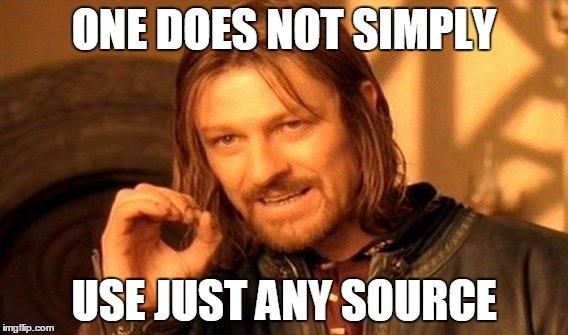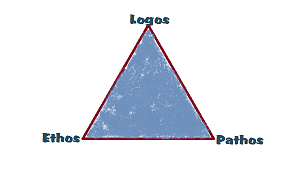Have you read our previous post called “Evaluating Sources Part I: General Tips”? If not, please visit the post here to learn more about how to evaluate sources! Today, instead of focusing on theoretical tips I’m going to give you some examples as food for thought.
Let’s imagine that you’re writing a paper on a controversial topic. It can be anything, but for the purpose of this illustration, let’s imagine you’re writing a paper about marijuana and if it should or should not be legalized. In your paper, you are arguing either for or against the legalization of marijuana, but we don’t have to choose one or the other in this scenario. You’re starting your research to back up your thesis, and you need to find some credible sources. As you look online you find three different articles that look appealing. (For the purpose of this example, I made up the sources below!)
- An article called “Marijuana Ruined My Life” by Bobby Cavendish on the website: ihatemarijuana.com.
- An article called “2016 Recreational Drug Usage Report” by Haley Stein, and published by the Institute of Medicine (U.S.).
- An article called “The Medical Benefits of Marijuana: Why I Smoke it Every day” by Sarah Washington on the website: 4204all.com/blazeit.
At face-value, analyze these sources. So which source would you choose and why would you choose it?
- “Marijuana Ruined My Life” by Bobby Cavendish and “The Medical Benefits of Marijuana: Why I Smoke it Every day” would probably not be your best bets for many reasons.
- The titles of the articles may not seem indicative of a bias at first. Often times, it’s hard to tell the difference between a source that takes a particular stance or has a particular argument vs. a source that is biased. There’s nothing wrong with a source that expresses a personal belief/opinion and uses personal experience. Sometimes, it’s even a good idea to use sources that express an opinion! However, it often times depends on what you’re writing about. For example, if you’re writing a final paper for a literature course, you wouldn’t want to use a blog post called “10 Reasons Why I Loved Frankenstein!”. Instead, you would want to use an objective source that offers more substantial information. However, there’s a fine line between a credible source with a strong argument and a non-credible biased source. This is why it’s a good idea to examine both the title of the source and where it comes from before actually engaging with the text.
- So, maybe the titles are just indicative of the authors’ stances, and not just biased. Next, you can analyze where the source comes from; in this case, ihatemarijuana.com and 4204all.com/blazeit. There are a few reasons why these websites seem problematic. For example, these websites aren’t traditional reliable sources because they’re unknown websites, (in comparison to other well-known websites like CNN, Forbes, HuffPost, etc.) and they don’t have a URL ending that indicates it’s from a credible source, like .org, .edu, .gov., etc. Furthermore, the URLs, like the titles, seem to express the authors’ strong opinions (Cavendish hates marijuana and Washington loves it) and this could mean that the sources are biased.
Out of the three choices I made up, your best bet would most likely be the “2016 Recreational Drug Usage Report” because it comes from a certified source, the U.S Institute of Medicine, and because the other two sources seem biased and do not come from trustworthy sources. Let’s imagine that you weren’t sure which option to choose by just analyzing the title of the article and the website name— it happens sometimes! The next thing you would want to do is take a closer look at the articles to see if they are credible.
Now, after all of this, you’re probably wondering what the point is. In the grand scheme of things, why does it matter if sources are credible or non-credible? Well, it all has to do with your own credibility as a student and as a writer!
If you write a paper and use sources that aren’t credible, can readers really trust you? For example, let’s imagine that you read an article online via the New York Times or Forbes or something like that. The article was well-written, had some awesome points, and you learned some really interesting things from it. However, you later found out some of those things weren’t true at all. Would you be confused? If some of the things weren’t true, who’s to say that there weren’t more false claims in the article? Would you be surprised or angry that you wasted time believing the things that the article claimed? This example is hyperbolic to say the least, but it also illustrates just how important credible sources are! Without credible sources, the foundation of your central thesis or argument could begin to crumble, and without a thesis or argument, how can your paper then be successful?
Overall, I’ve briefly highlighted the importance of credible sources. Like I said before, practice makes perfect, so don’t be discouraged if you find it hard to distinguish credible and non-credible sources at first! Remember to always question your sources and that will definitely help you as you work. Also, if you need further reference, feel free to check out some of the amazing sources below!
–Katherine
Resources Consulted:
http://library.ucsc.edu/help/research/evaluate-the-quality-and-credibility-of-your-sources
https://owl.english.purdue.edu/owl/resource/553/01/
https://owl.english.purdue.edu/owl/resource/553/02/
http://isites.harvard.edu/icb/icb.do?keyword=k70847&tabgroupid=icb.tabgroup107786
https://digitalliteracy.cornell.edu/tutorial/dpl3221.html
https://www.lib.ncsu.edu/tutorials/evaluating-sources/
http://guides.lib.berkeley.edu/evaluating-resources
http://guides.library.jhu.edu/c.php?g=202581&p=1334914
http://www.usg.edu/galileo/skills/unit07/internet07_08.phtml


















